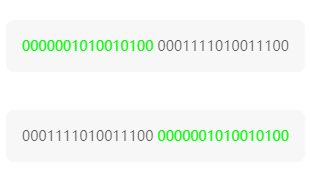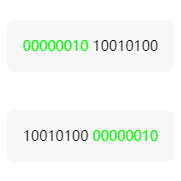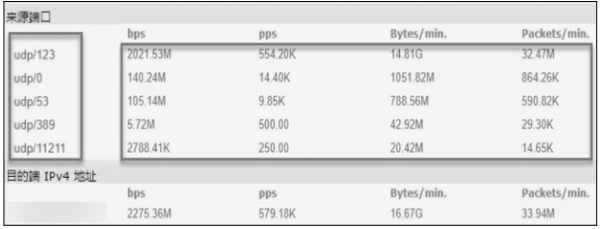题目链接: https://leetcode.cn/problems/reverse-bits/
视频题解: https://www.bilibili.com/video/BV1W2421Z7bi/
LeetCode 190.颠倒二进制位
题目描述
颠倒给定的 32 位无符号整数的二进制位。
举个例子:
输入:n = 00000010100101000001111010011100
输出:964176192 (00111001011110000010100101000000)
解释:输入的二进制串 00000010100101000001111010011100 表示无符号整数 43261596,
因此返回 964176192,其二进制表示形式为 00111001011110000010100101000000。
视频题解
颠倒二进制位
思路来源
思路来源
知识回顾
- 左移运算符
<<,可以将一个对象的二进制向左移n位,左边n位丢弃,右边n位补0。比如,a = 1101。
a << 2 = 0100
- 右移运算符
>>,可以将一个对象的二进制向右移n位,右边n位丢弃,左边n位补0。比如,a = 1101。
a >> 2 = 0011
思路解析
方法一 按位颠倒
我们先将题目简化一下,对于一个8位的二进制10110111,如何进行颠倒成11101101呢?
先定义一个8位无符号的res = 0,我们将二进制的第i位,放到res的第7 - i位(位数从0开始)就可以完成整个过程的翻转。过程如下图:

针对上面的结论稍加修改就可以应用到32位无符号整数上面。
先定义一个存放结果的32位无符号变量 res = 0,循环遍历原串二进制的第i位,将其放到res的第31-i位,遍历完原串即得到最终翻转后的结果res。
C++代码
class Solution {
public:
uint32_t reverseBits(uint32_t n) {
uint32_t res = 0;
for (int i = 0; i < 32; ++i) {
//原串的第i位
int bit = n & 1;
//将原串的第i位放到res的第31-i位
res |= (bit << (31 - i));
n >>= 1;
}
return res;
}
};
java代码
public class Solution {
// you need treat n as an unsigned value
public int reverseBits(int n) {
int res = 0;
for (int i = 0; i < 32; ++i) {
// 原串的第i位
int bit = n & 1;
// 将原串的第i位放到res的第31-i位
res |= (bit << (31 - i));
n >>= 1;
}
return res;
}
}
python代码
class Solution:
def reverseBits(self, n: int) -> int:
res = 0
for i in range(32):
# 原串的第i位
bit = n & 1
# 将原串的第i位放到res的第31-i位
res |= (bit << (31 - i))
n >>= 1
return res
方法二 分治
下面介绍另一种分治方法,对一些刚刷题的同学来说可能比较难理解。
- 把
32位分成左右两部分16位,左右两部分交换。可以通过n = (n >> 16) | (n << 16)来做到。

- 把
16位分成左右两部分8位,左右两部分交换。可以通过n = ((n & 0xff00ff00) >> 8) | ((n & 0x00ff00ff) << 8)来做到。16进制0x00ff00ff和32位二进制0000 0000 1111 1111 0000 0000 1111 1111是等价的,0xff00ff00和1111 1111 0000 0000 1111 1111 0000 0000是等价的。

- 把
8位分成左右两部分4位,左右交换。可以通过n = ((n & 0xf0f0f0f0) >> 4) | ((n & 0x0f0f0f0f) << 4)来做到。16进制0xf0f0f0f0和二进制1111 0000 1111 0000 1111 0000 1111 0000是等价的,0x0f0f0f0f和0000 1111 0000 1111 0000 1111 0000 1111是等价的。

- 把
4位分成左右两部分2位,左右交换。可以通过n = ((n & 0xcccccccc) >> 2) | ((n & 0x33333333) << 2)来做到。16进制0xcccccccc和二进制1100 1100 1100 1100 1100 1100 1100 1100等价,0x33333333和二进制0011 0011 0011 0011 0011 0011 0011 0011等价。

- 把
2位分成左右两部分1位,左右交换。可以通过n = ((n & 0xaaaaaaaa) >> 1) | ((n & 0x55555555) << 1)来实现。其中16进制0xaaaaaaaa和二进制1010 1010 1010 1010 1010 1010 1010 1010等价,0x55555555和0101 0101 0101 0101 0101 0101 0101 0101等价。

C++代码
class Solution {
public:
uint32_t reverseBits(uint32_t n) {
//左右16位交换
n = (n >> 16) | (n << 16);
//左右8位交换
n = ((n & 0xff00ff00) >> 8) | ((n & 0x00ff00ff) << 8);
//左右4位交换
n = ((n & 0xf0f0f0f0) >> 4) | ((n & 0x0f0f0f0f) << 4);
左右2位交换
n = ((n & 0xcccccccc) >> 2) | ((n & 0x33333333) << 2);
左右1位交换
n = ((n & 0xaaaaaaaa) >> 1) | ((n & 0x55555555) << 1);
return n;
}
};
java代码
public class Solution {
// you need treat n as an unsigned value
public int reverseBits(int n) {
// 左右16位交换
n = ((n >> 16) & 0x0000ffff) | ((n << 16) & 0xffff0000);
// 左右8位交换
n = ((n >> 8) & 0x00ff00ff) | ((n << 8) & 0xff00ff00);
// 左右4位交换
n = ((n >> 4) & 0x0f0f0f0f) | ((n << 4) & 0xf0f0f0f0);
// 左右2位交换
n = ((n >> 2) & 0x33333333) | ((n << 2) & 0xcccccccc);
// 左右1位交换
n = ((n >> 1) & 0x55555555) | ((n << 1) & 0xaaaaaaaa);
return n;
}
}
python代码
class Solution:
def reverseBits(self, n: int) -> int:
# 左右16位交换
n = (n >> 16) | (n << 16)
# 左右8位交换
n = ((n & 0xff00ff00) >> 8) | ((n & 0x00ff00ff) << 8)
# 左右4位交换
n = ((n & 0xf0f0f0f0) >> 4) | ((n & 0x0f0f0f0f) << 4)
# 左右2位交换
n = ((n & 0xcccccccc) >> 2) | ((n & 0x33333333) << 2)
# 左右1位交换
n = ((n & 0xaaaaaaaa) >> 1) | ((n & 0x55555555) << 1)
return n
复杂度分析
时间复杂度: 两种方法都是 O(1),最多处理32位,分治是log32位,都是常量时间。
空间复杂度: 两种方法都是 O(1),只使用有限个整型变量。












![input[type=checkbox]勾选框自定义样式](https://i-blog.csdnimg.cn/direct/100abf837dd6477d9ff52f0936d0cc33.png)






